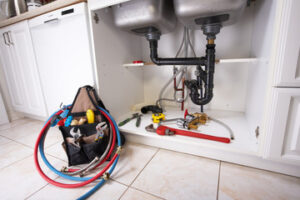Residential plumbing involves dealing with private residences and their plumbing systems. It requires excellent customer service skills because you will be working directly with the client.
In contrast, commercial plumbing deals with high-rise offices, shopping centers, multiuse buildings, hospitals, and restaurants. It has more complex plumbing systems and stringent regulations in some cases.
A plumbing system consists of the piping and fixtures that transport water, sewage, and other liquids throughout a building. Its primary function is to provide a safe and healthy supply of potable water to its occupants. This includes drinking water, cooking water, and washing water. It also ensures that waste is safely transported away from a building and into a sewer or septic tank.
Residential plumbing systems are linked to municipal water pipes in urban areas and to septic tanks or septic fields in rural homes. The plumbing system in a home uses pipes of different sizes to accommodate different needs. For example, toilets require smaller-diameter pipes than sinks and bathtubs. The water supply system routes municipal water from a water main to the house and then branches out to deliver water to faucets, showers, toilets, and appliances such as washers and dishwashers.
The drainage system carries wastewater from basins, kitchen sinks, toilets, and laundry appliances to the sewer or septic tank. It may use a gravity-fed system or a pump-based system. Pumps may be required when the ground slope is too steep for a gravity-fed system.
A plumbing system’s piping is generally made from polyvinyl chloride (PVC) or cross-linked polyethylene (PEX). These pipes are durable, resistant to corrosion, and can handle high water pressure. Other materials include copper, galvanized steel, and cast iron. Plumbing systems also incorporate a variety of valves and fittings that connect the pipes together. These parts are available in many styles and finishes to complement any décor. The key to a successful plumbing system is proper design, installation, and maintenance. Regular plumbing maintenance from qualified professionals can reduce the risk of costly repairs, water leaks, and other problems.
Water Service Lines
The water supply line extends from the potable water source (usually a public main in the street) to the building. The water line is often made of copper or ductile iron but can also be made of plastic, lead, galvanized steel, cast iron, or other materials. The water line is typically insulated and supported with pipe hangers to prevent sagging. The hot and cold water lines run from the water meter through the house to the fixture supply risers. These pipes are sized for the amount of water that will be used at any one time, and their location in a house should allow them to withstand the expected water pressure.
The residential plumbing system also includes the piping that connects the house to the sewer, the gas line, and electricity for heating. It is important for a housing inspector to understand the basics of these piping systems in order to identify any housing code violations that involve plumbing.
In areas where public water is available, there are large-diameter pipes that supply the entire town. These are called distribution mains, and they are tapped by individual water service lines in each home and business. The taps on the water service lines are usually marked with a letter or number. The water service lines then branch to each home and to the faucets, toilets, showers, dishwashers, and other appliances in the house.
Many water systems have good records of the material that was used to make up the portion of the water service line that is public property. The information about the portion of the water line that is on private property, however, is less reliable. This is why it is important for the inspector to know how to work with a water system to reveal the line and confirm its material.
Water distribution system
The water distribution system carries treated water from the water treatment plant and wells to consumers to meet residential, commercial, and firefighting requirements. It is comprised of pumps, reservoirs, meters, valves, and pipes. The size and layout of a distribution system depend on the topography, street plan, and location of the source.
Typically, there is one primary water transmission line, or main, that transports water from the source to a distribution reservoir. From there, the water is distributed to consumers through a series of smaller pipes, or mains.
When designing a water distribution system, it is critical to consider the pressure required, potential growth areas, staff time commitment for operations and maintenance, and desired fire protection. In addition, it is important to maintain a level of pressure throughout the entire distribution system so that water can be delivered quickly to each home or business when requested.
Depending on the community’s needs, there are many different types of distribution systems. A grid system, which consists of connected pipe loops throughout the service area, is often used in larger municipalities. This configuration reduces the possibility of dead ends and allows for more flexible firefighting capabilities. However, it can lead to water quality problems if the looping pattern is not carefully controlled.
Another type of water distribution system is a 3-pipe system. This consists of two supply mains (one for hot and one for cold) and a return main. The supply and return lines are sized to meet normal standards. In addition, this system can be set up with a direct return or a reverse return. In either case, the return is sized to handle the maximum flow rate.
Water Heater
Most homes in the US use tank water heaters. This is a heavy metal vessel that holds 40 to 60 gallons (151 to 227 liters) of hot water at 50 to 100 pounds per square inch (PSI). The tank has an insulated outer shell and is usually painted to reduce the risk of corrosion. A dip tube draws water from the bottom of the tank and enters the hot water service line at the top. Because hot water has less density than cold water, the hottest water rises to the top of the tank. The tank also has a drain valve near the bottom and a shut-off valve on the outside. A professional plumber can help you choose and maintain the right tank water heater for your household needs.
A gas tank water heater uses natural gas, heating oil, propane, or another fuel to heat the water. It should be installed with a safety device that shuts off the gas supply when it reaches 99 °C (210 °F) and an expansion tank to reduce pressure on the pipes, valves, and the water heater.
Fixtures
Besides water supply pipes and hot and cold water tanks, a plumbing system requires various types of fixtures to deliver water and remove wastewater. These fixtures include toilets, sinks, bathtubs, and shower receptors, among others. They are made of durable materials such as porcelain, copper, steel, cast iron, or fiberglass and are available in a wide range of styles and colors to suit your decor. They are also designed with different functions depending on their purpose. For instance, some offer improved spray technology and energy savings, while others are designed to reduce the risk of leaks and spills.
The term “fixture” refers to any item that is connected to a plumbing system and has a permanent impact on how the system operates. For example, a sink or toilet is considered a fixture because it is permanently connected to the water supply and drain lines in a building.
Residential plumbing fixtures are important in ensuring that buildings remain hygienic and safe. Without them, people would have a hard time washing themselves and disposing of waste. Besides, they help to ensure that the water in a building is clean and suitable for drinking.
When a sink, tub, or shower is not properly installed, it can leak or cause health problems. Therefore, it is important to ensure that these fixtures are installed by a professional plumber. This will prevent them from leaking or becoming damaged.


